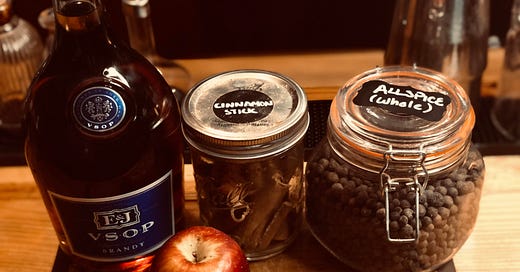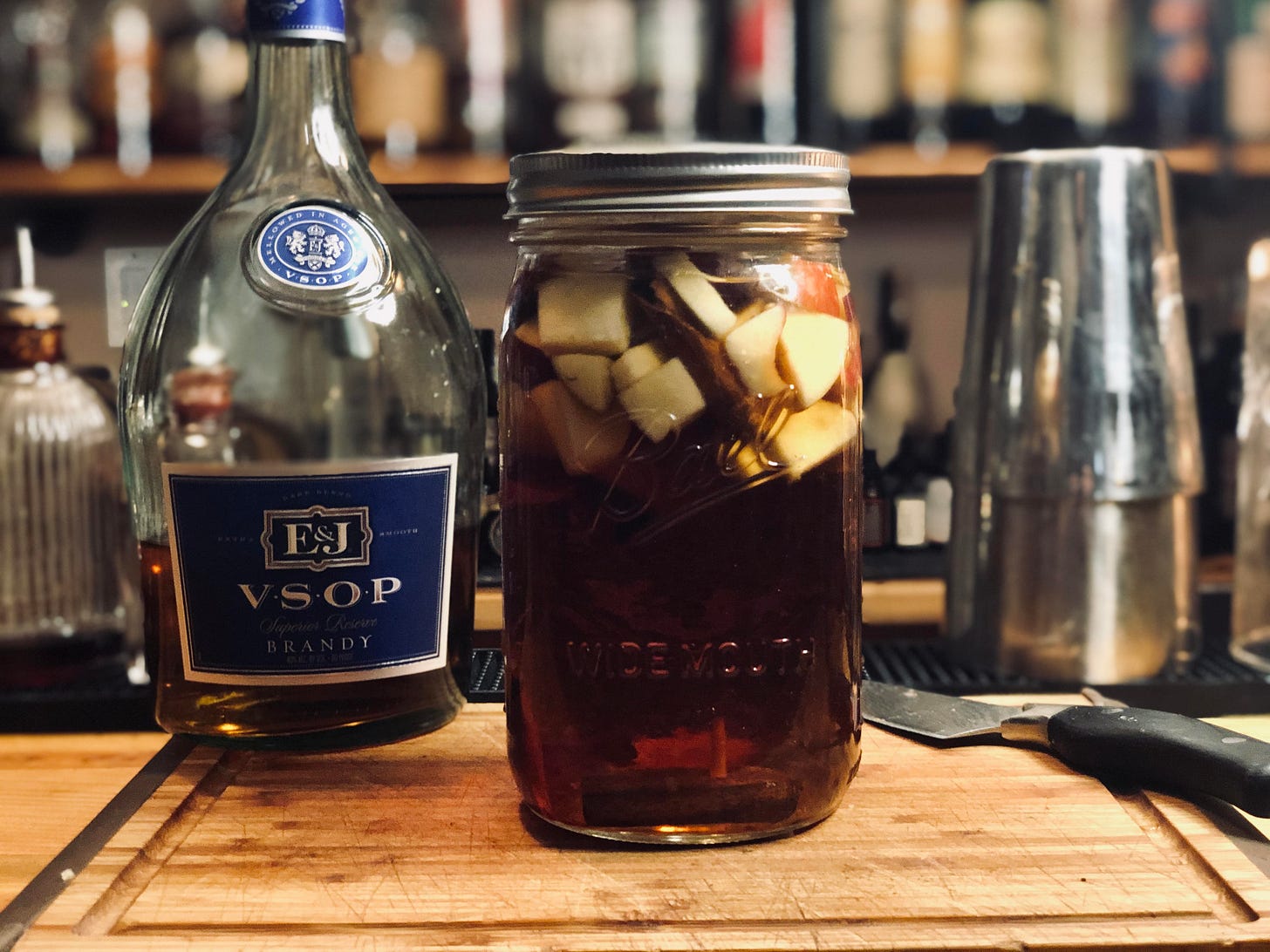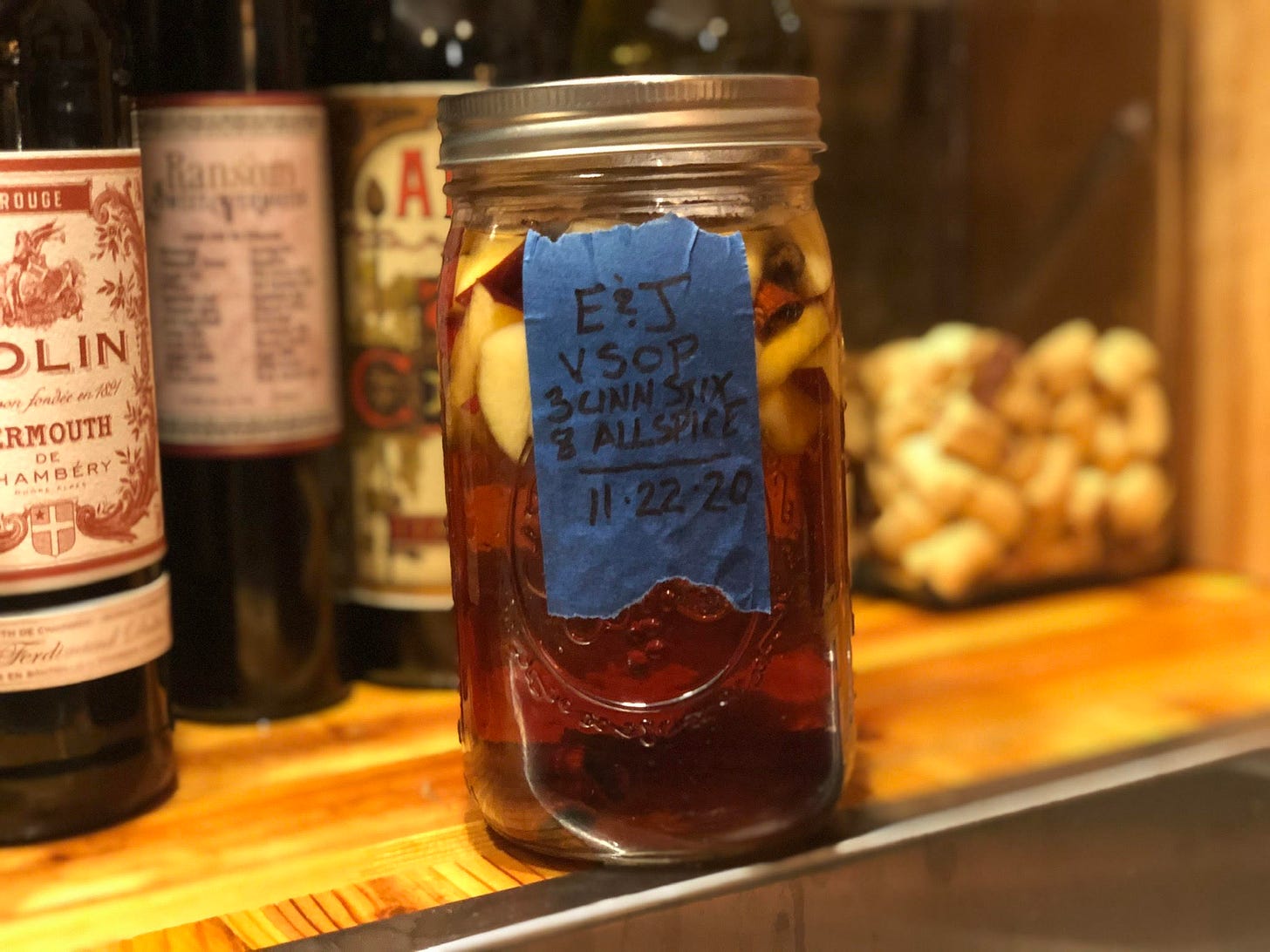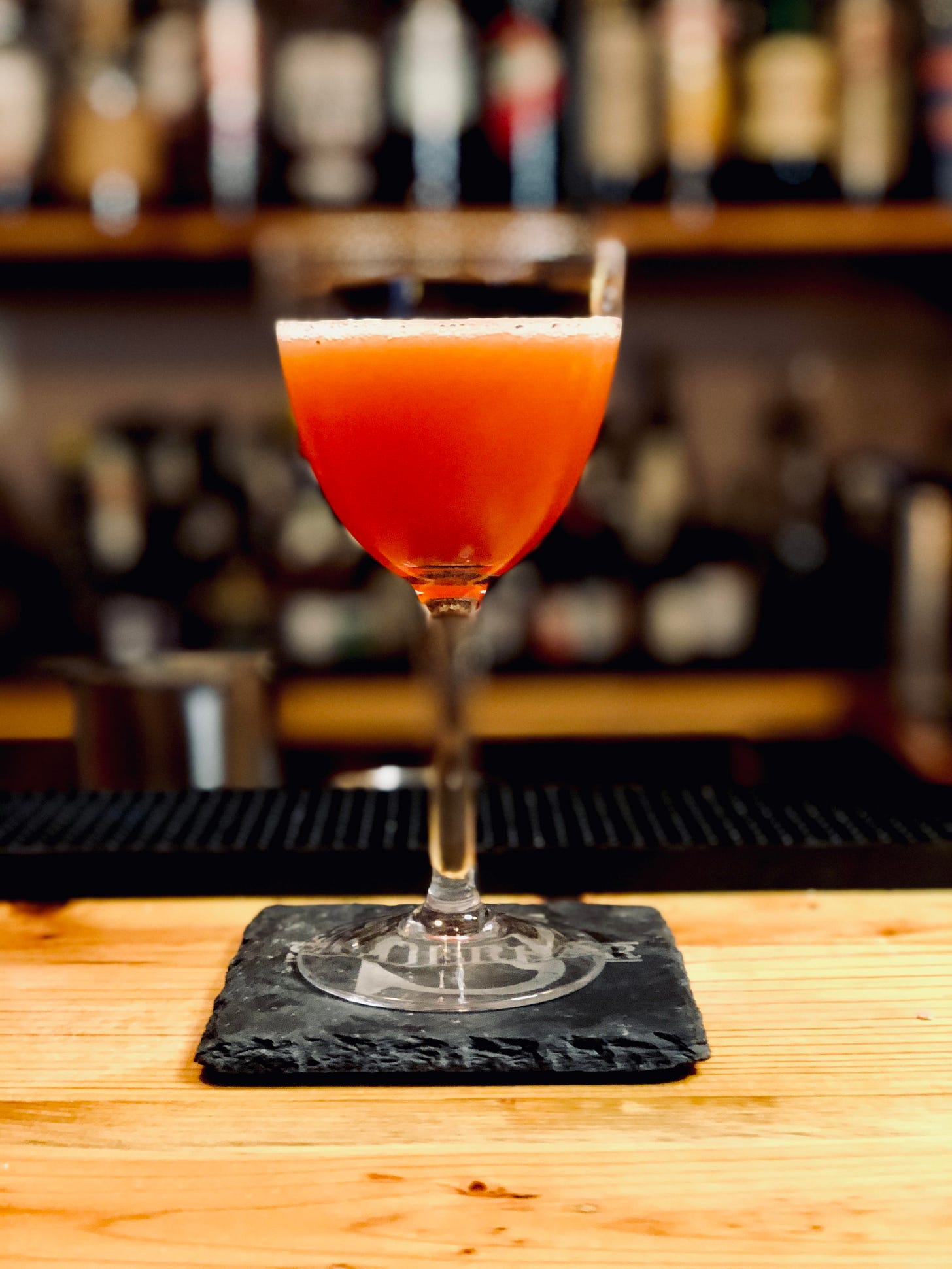It’s Almost Thanksgiving. Let’s Make an Infused Brandy Sour.
Apple! Cinnamon! Allspice! Also: a Thanksgiving Old Fashioned.
When I first started thinking about this newsletter, I had it all carefully planned out — a slow and careful sequence for building drink-making skills, with things like multi-day infusions far down the list. We haven’t even gotten to stirring and shaking yet! But this year has been terrible for plans and planners. So we’re just going to dive right into a higher-level technique or two today. Embrace the chaos!
So! It’s almost Thanksgiving. What drink are you going to make?
Holiday cocktails are a lot like holidays: You want to make them special — but not too much work. Ideally, they should appeal to everyone in the family (or at least everyone old enough to drink).
Granted, holiday gatherings this year may not be large. If there’s a benefit to smaller groups, it’s that they give you license to experiment: With fewer people, there isn’t quite so much pressure to get it exactly right.
That means you can try your hand at a modest cocktail project. Something, for example, like a quick infusion. I promise it will only take a few days.
Now, I can imagine what you might be thinking: Days? Really? For just one single solitary cocktail?
But come on: What else are you doing this week? Especially this ridiculous year. You probably need a project. You need something to occupy your mind and your time, a distraction from...well, everything. Here’s one that will pay off in liquid form.
Also, the actual amount of time spent working on the drink is minimal — just a few minutes on each end. And you’re not just going to make one cocktail. You’re going to make two.
The Ideal Turkey Day Cocktail
Let’s back up a little bit. What are we looking for in a Thanksgiving cocktail project? Ideally, you want something that:
1) is accessible to the masses: I might like a boozy, bitter Black Manhattan after my turkey dinner. It’s a great drink. But I probably wouldn’t serve one to my mother in law. A Thanksgiving cocktail should be a little more easygoing.
2) has some unique elements that aren’t prohibitively expensive: If you have a thousand-year-old bottle of scotch sitting in the liquor cabinet, go ahead and pass it around, but for a cocktail project, you probably want to work with more modest — yet still tasty — ingredients.
3) incorporates traditional holiday flavors: apple, cinnamon, warming spices, etc. You want it to taste like Thanksgiving!
And if you’re me, you probably want it to be built on a classic cocktail construction. Which means that most likely, you’re looking at something in the sour family.
Sours are shaken drinks that balance the spirit between citrus, typically fresh lemon or lime juice, and a sweetener, typically a syrup of some sort. Made well, they are flavorful, tart, layered, and easy to drink without being overly sweet. Because they rely on relatively large portions of sugar and juice, at least compared to the austerity of an Old Fashioned, they are great crowd-pleasers. Sours are fancy cocktails for normies.
Like all cocktails, they offer a flexible template for innovation. Sours can take many forms, and I’ll write a lot more about them in coming newsletters. But one of the most common structures is this:
¾ ounce syrup/sweetener
¾ ounce citrus
2 ounces spirit
So a classic daiquiri is a sour made with rum, lime, and some sort of sugar syrup. A whiskey sour is a sour made with whiskey, lemon, and syrup. A Tommy’s Margarita is a sour made with tequila, lime, and agave syrup.
Sometimes the formula expands to include an egg white, or bitters, or salt. Sometimes the spirit gets split into multiple parts. Sometimes the proportions shift in various ways.
But the essential formula always remains more or less the same: Spirit, citrus, sweetener. In the same way that an Old Fashioned is a spirit balanced by bitter and sweet, a sour is a spirit balanced by sweet and sour.
For this Thanksgiving, then, we’re going to make a sour — a Thanksgiving Sour.
Weren’t We Making an Infusion?
We were! But before we get to that, it’s helpful to decide what to infuse, and with what ingredients.
It’s fall. It’s cool outside. You’re celebrating an intrinsically American holiday. So for purposes of thematic unity, you probably want to use a brown liquor made in the good old U.S. of A.
It’s tempting to start with bourbon. It’s an American spirit, good for an American holiday. It has corn notes, and tastes of caramel, leather, and harvest grains.
But at lower price points, bourbon struggles to find a balance between too harsh and too bland, and it doesn’t always play well with other flavors.
Rye mixes a little better, but it’s typically a little more expensive, and the spicy/pepper notes can overpower other flavors — as well as some drinkers.
So what about brandy?
Yes, I know, brandy is the province of the French. And French brandy can indeed be great. I will never complain about a sip of Hine or Pierre Ferrand Cognac, or tell anyone not to drink it. But American brandy can be surprisingly good. It’s also widely available, and, even better, some of it is dirt cheap.
Which is why my Thanksgiving Sour starts with E&J VSOP brandy, which can be had for under $15 a bottle pretty much anywhere in the country. It’s a spirit that embodies the values of our earliest Thanksgiving celebrations, which were designed as rejections of European stuffiness. The Thanksgiving meal was about making a meal with good stuff that was all around you, even if it was particularly highbrow.
The VSOP is an aging designation for brandy that stands for “Very Superior Old Pale,” which in this case means it’s been aged for at least two years — more than VS, but not quite as much as XO. It’s the middle ground.
E&J VSOP brandy is incredibly smooth and caramel-y, with notes of dried fruit, vanilla bean, brown sugar, and winter spice. Stick your nose in a bottle, and you’ll smell gentle aromatics that won’t overwhelm other flavors, which makes it easy to mix. It’s not going to win top honors for complexity or uniqueness of character, but it’s also not going to turn off many people either. It has the most important quality of inexpensive booze which is that there is nothing obviously wrong with it. It’s a mild, competent, inexpensive spirit.
Infusions: Liquor + Other Stuff to Make It Smell and Taste Better
That, in turn, makes it great for infusing. Infusions tend to work best with sturdy, not-too-complex base liquors that provide a platform for flavor enhancement. You’re not looking for the booze equivalent of an architectural wonder; instead, you want a nice, white, blank room — something you can spruce up and take in whatever direction you want.
In this case, the way you’re going to spruce it up is with an infusion of apple, cinnamon, and all spice — fall flavors that will fit right in with a Thanksgiving meal.
Infusions take a little bit of time, and a little bit of effort, but the concept is really quite straightforward: Take foodstuffs — typically but not always fruits and spices — and mix them with liquor. Let the mixture sit for some period of time, then strain out the solids. Suddenly your mild, competent spirit will have a whole new flavor profile. It’s really that easy.
For this specific infusion, you will need the following ingredients:
1 apple, diced
3 cinnamon sticks, broken into 2-3 pieces
8 whole Allspice berries
1 bottle of E&J VSOP
A couple of notes: It’s not too important what kind of apple you use, but try to avoid Granny Smith or anything too tart. Similarly, for the cinnamon, you don’t need anything special; I order bags of cinnamon sticks from Amazon. But you can get both the cinnamon and the allspice from your local grocery store if you don’t have time.
For the brandy, you can use a standard 750 ml bottle, but I recommend buying a 1 liter bottle if you can find one. They’re not much more expensive, and it will leave you a little bit of extra to taste and experiment with. As I noted earlier, this recipe will work with the even-less-expensive, younger VS, but I prefer it with the smoother, longer-aged VSOP.
First dice your apple. Then count out your berries and your cinnamon sticks. Break each cinnamon stick into 2-3 pieces. Combine all your infusing elements in a sealable container that will hold at least 30 ounces — I use 32 ounce Ball mason jars, mostly because I have a lot of them around and they have wide openings. But you can use Tupperware too.
Finally, pour in about 25 ounces of brandy — roughly the equivalent of one 750ml bottle. You don’t need to worry about being super exacting. Cocktails frequently require high levels of precision, but for an infusion, especially one you’ve never done before, you can chill out: The goal is to impart some flavors using ingredients that should get along. Think of it like setting up a dinner party with some friends who don’t know each other yet, but ought to hit it off. Your job is to get them together in a comfortable environment, then let things run their course. An ounce or two one way or the other won’t make too much difference, though if you want to cut the recipe in half or double it, you’ll want to reduce or increase the infusing agents. Each drink will use two ounces of your infused brandy, so think about how many you’re likely to make.
Once you’ve combined all the ingredients in the jar and sealed it, you have one last step: Label it. Your label should include the basic ingredients involved as well as the date.
This is important. Make enough home cocktail experiments — infusions, syrups, amaros, blends, infinity bottles, what have you — and you will soon find yourself with bottles and bottles of unmarked ingredients. You will not know what they are, or when they were made, or if they are still good to drink. The profusion of unmarked ingredients of ambiguous makeup will drive you and anyone you live with mad. Always. Label. Everything. Trust me. (I often use blue painter’s tape, but washable labels can be very helpful. It doesn’t have to be pretty; it just has to be functional.)
Now, take your labeled bottle and store it away somewhere. You don’t need to chill it, but do try to store it someplace where it won’t be subject to big temperature swings or too much direct sunlight. In my case, that means on the back shelf of the bar, next to the vermouth...and, uh, the dog treats (a good home bar should have something for everyone in the family).
And then...you wait. Two or three days should be enough — and at this point it’s all you have before Thanksgiving. Sometime on Turkey Day, before the big meal, strain out the solids using a fine mesh strainer of some sort. I use a chinois with a stand and a big plastic bowl with a pour spout, but any basic fine mesh strainer, or even just cheese cloth, should work just fine.
You now have apple-cinnamon-allspice infused brandy. Pour a little taster for yourself; see how the alcohol absorbed the flavors, how it now tastes of fall flavors. The new flavors shouldn’t overpower the drink, but they should be fairly prominent. It’s a makeover, not a body-switch.
Eventually you will need to put this into some sort of storage container; another mason jar will do, but if you have recently finished a liquor bottle with a plastic screwtop — something like Old Overholt or Laird’s Apple Brandy — you can just wash it out and use that. Whatever you do, make sure to label it, including the date.
Let’s Make a Cocktail!
Now that you’ve made your infused booze, you’re ready to make your cocktails.
The first one, and the main event, is the Thanksgiving Sour. Its construction is designed to showcase the infused flavors with a sweet/tart balance, and the addition of a bit of warming spice notes from the bitters. It’s a simple, shaken drink, served up in a coupe or Nick & Nora glass. (Any cocktail glass will do, but if you don’t have one, just serve it in the smallest wine glass you have.)
Thanksgiving Sour
1 dash Angostura bitters
¾ ounce rich simple syrup (see recipe below)
¾ ounce fresh squeezed lemon juice (yes, really, it has to be squeezed fresh)
2 ounces infused brandy
Combine all ingredients in a cocktail shaker. Add ice, then shake vigorously for 10-15 seconds until the outside of the shaker is cold. Strain into a coupe or Nick & Nora glass.
The drink should have a reddish, autumnal hue, and if you’ve shaken properly, a lightly aerated foam top. You should taste the base brandy, the lemon, and the syrup, but all those flavors should be lightly but distinctly modified by the apple, cinnamon, and allspice, as well as the aromatic bitters.
This is the cocktail I serve before Thanksgiving dinner, while everyone is waiting for the main event. I like being responsible for pre-dinner drinks in part because it gives me something to do. My wife and her family take Thanksgiving dinner very seriously, and they are very, very good cooks, so otherwise my main contributions are to set the table and help clean up.
We won’t have our usual big group over for Thanksgiving this year, and I’ll be honest: I’m a little sad I won’t be able to make this drink for a bunch of people — but I’m glad I can share it with you.
You Promised a Second Drink!
Indeed I did. So here’s what you’re going to do: You’re going to take your infused brandy and make an Old Fashioned out of it.
This is the drink after the night’s over, after all the dishes have been washed, after everything has calmed down and everyone’s belly is full of delicious turkey. It’s a bit dessert-like — sweet and rich — without being cloying.
In the previous newsletter, I discussed how Old Fashioneds, though most commonly made with a whiskey base, can be made from practically any spirit because the Old Fashioned is a formula, a system, a template — not a single specific recipe. Your bottle of infused brandy will make a fine holiday Old Fashioned. You just have to put it through the system.
You’ve already chosen your spirit, which means you have two choices left: sweetener, and bitters.
This is a cold weather holiday drink. It’s supposed to feel cozy. So while you could easily make a rich demerara syrup work, my choice would be maple syrup, the thicker and heavier the better, in order to give the drink some added viscosity. Conveniently, maple syrup is something you don’t have to go out of your way to make.
As for bitters, you can’t go wrong with Angostura aromatic bitters. If that’s what you’ve got, then use them. But if you want the drink to taste like fall on overload, try Fee Brothers Black Walnut bitters, which match the brandy almost too well.
There’s one last choice that I didn’t discuss last time: garnish. While I usually go with an orange peel for Old Fashioned style drinks, the dessert-like, holiday nature of this drink calls for a cherry, specifically a Luxardo Maraschino cherry. (If you can’t find Luxardo cherries, just skip the garnish; it will still be delicious.) Make sure to spoon a tiny amount of the syrup into the drink as you drop the cherry in; it’ll add a further hint of fruit sweetness to the drink.
(If you bought a 1 liter bottle of E&J and have some un-infused brandy left, try this with the un-modified spirit, which makes a nice, mellow Old Fashioned all on its own.)
Here’s the recipe:
Thanksgiving Old Fashioned
2 dashes Fee Brothers Black Walnut Bitters (can substitute Angostura)
¼ ounce maple syrup (you can drop this to 1 tsp if you find it too sweet)
2 ounces infused brandy
Combing ingredients in a mixing glass. Add ice; stir 20-30 times until chilled. Strain over a single large piece of ice in a rocks glass. Garnish with a Luxardo Maraschino cherry. Enjoy. Relax. You made it through another Thanksgiving. Now you just have to think about what you’re going to make for Christmas.
Rich Simple Syrup
Simple syrup is a 1:1 blend of sugar to water. Rich simple syrup is a 2:1 blend of sugar to water, for a sweeter, thicker syrup.
The easiest way to make this extremely useful syrup is to use a blender to combine two parts sugar by weight to one part water. So: Combine 400 grams of white sugar and 200 grams of water in a blender, blend for 60-90 seconds at high speed, then pour into a storage container (I like 16 ounce plastic squeeze bottles, for ease of use). If you don’t have a scale, you can measure by volume: 12 ounces of sugar to 6 ounces of water.
And if you don’t have a blender, you can make it on the stovetop: Combine two parts sugar and one part water in a saucepan, heat right up to the point where it’s about to start boiling, then turn down to a simmer. After 10-20 minutes on simmer, turn off the heat, then let cool for 30-60 minutes at room temperature. Pour into a storage container and keep cool in the refrigerator.
Don’t Want to Make An Infusion?
If all this sounds like too much work, here are a couple of suggestions that require less prep time.
Flor de Jerez
This drink from Death & Co. is a rich, delicious fall sour, built on a base of nutty sherry and golden rum. Notice how it follows the same three-part structure as the Thanksgiving sour, even though the parts have been split up: ¾ ounce of sweetener, ¾ ounce of citrus, 2 ounces of base spirit.
1 dash Angostura bitters
½ ounce simple syrup
¼ ounce Rothman & Winter apricot liqueur
¾ ounce fresh squeezed lemon juice
½ ounce golden rum, like Appleton Reserve
1 ½ ounce Amontillado sherry
Combine ingredients in a cocktail shaker, add ice, shake for 10-15 seconds until the shaker is chilled. Strain into a coupe or Nick & Nora glass.
Salted Maple Whiskey Sour
A slight twist on the old favorite that relies on maple syrup and a hint of salt. It’s best with juice from slightly sweeter Meyer lemons.
3-4 drops of saline solution or 1 pinch of table salt
¾ ounce maple syrup
¾ ounce fresh squeezed lemon juice
2 ounces Old Overholt rye
Combine ingredients in a cocktail shaker, add ice, shake for 10-15 seconds until the shaker is chilled. Strain into rocks glass over a single large piece of ice.
***
Cocktail Library: The Aviary Holiday Cocktail Book, by Grant Achatz, Nick Kokonas, and Allen Hemberger. The Aviary is known for its intensely elaborate cocktail creations, many of which are nearly impossible to recreate at home, even with detailed instructions. Still, even the most difficult drinks can provide inspiration for less arduous techniques.
Planning on making something else for Thanksgiving? Just drinking scotch? (For Thanksgiving, I’d go with Bunnahabhain 12 myself.) Share what you’re making and drinking in the comments below.







Peter - (or any of the rest of yall) - the only thing I haven't nailed here is the color on that sour. Mine is less red, more shading into the browish side of orange. . .any tips?
Still tastes delicious!
Peter - giving the infusion a go this year! Question: is finished infusion shelf stable at room temp? Or (given use of fresh apple) should it be stored in fridge?